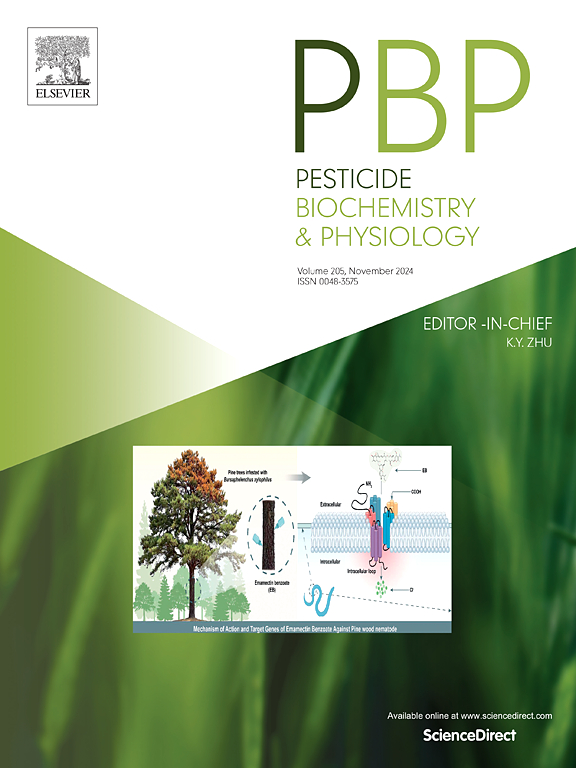Expression and sex pheromone-binding characteristics of pheromone-binding protein 3 in Tuta absoluta (Lepidoptera: Gelechiidae)
IF 4.2
1区 农林科学
Q2 BIOCHEMISTRY & MOLECULAR BIOLOGY
引用次数: 0
Abstract
The olfactory system plays a crucial role in insect survival and reproduction. Odorant-binding proteins (OBPs) are essential for odor discrimination and hold the potential to be targets for pest management. Tuta absoluta (Lepidoptera: Gelechiidae), a devastating invasive pest of Solanaceae crops, has limited research on its OBPs. In this study, 34 OBP genes were identified in T. absoluta, including TabsGOBP1, TabsGOBP2, TabsPBP1a, TabsPBP1b, TabsPBP1c, and TabsPBP3, which belong to the Lepidoptera-specific GOBP/PBP subclass. Expression profiling revealed TabsPBP3 to be predominantly expressed in male antennae and the female pheromone gland-ovipositor complex, with peak expression at 6:00 AM associated with courtship and mating behavior. Fluorescence competitive binding assays demonstrated that TabsPBP3 strongly binds to the main pheromone component (3E, 8Z, 11Z)-tetradecatrien-1-yl acetate (TDTA) but exhibits weak or no affinity for other components. Molecular docking identified key active sites in TabsPBP3, including Phe37, Tyr61, Ile77, Leu84, Ile86, Leu87, Phe101, Ala136, Ile139, and Ala140, which facilitate interaction with TDTA. These findings establish TabsPBP3 as a key player in TDTA detection and provide foundational data for innovative pest control strategies targeting T. absoluta.

信息素结合蛋白3在绝对大蠊体内的表达及性信息素结合特性(鳞翅目:蠓科)
嗅觉系统在昆虫的生存和繁殖中起着至关重要的作用。气味结合蛋白(OBPs)对气味识别至关重要,并有可能成为害虫管理的目标。摘要绝对球蛾(鳞翅目:球蛾科)是一种对茄科作物具有破坏性的入侵害虫,目前对其OBPs的研究较为有限。本研究共鉴定出34个OBP基因,包括TabsGOBP1、TabsGOBP2、TabsPBP1a、TabsPBP1b、TabsPBP1c和TabsPBP3,属于鳞翅目特异性的GOBP/PBP亚类。表达谱显示,TabsPBP3主要在雄性触须和雌性信息素腺体-产卵器复合体中表达,在早上6点达到表达高峰,与求偶和交配行为有关。荧光竞争结合实验表明,TabsPBP3与主要信息素成分(3E, 8Z, 11Z)-乙酸四酯(TDTA)结合较强,而与其他成分亲和力较弱或无亲和力。分子对接发现了TabsPBP3中促进与TDTA相互作用的关键活性位点,包括Phe37、Tyr61、Ile77、Leu84、Ile86、Leu87、Phe101、Ala136、Ile139和Ala140。这些发现为TabsPBP3在TDTA检测中的重要作用奠定了基础,并为创新针对绝对白僵虱的害虫防治策略提供了基础数据。
本文章由计算机程序翻译,如有差异,请以英文原文为准。
求助全文
约1分钟内获得全文
求助全文
来源期刊
CiteScore
7.00
自引率
8.50%
发文量
238
审稿时长
4.2 months
期刊介绍:
Pesticide Biochemistry and Physiology publishes original scientific articles pertaining to the mode of action of plant protection agents such as insecticides, fungicides, herbicides, and similar compounds, including nonlethal pest control agents, biosynthesis of pheromones, hormones, and plant resistance agents. Manuscripts may include a biochemical, physiological, or molecular study for an understanding of comparative toxicology or selective toxicity of both target and nontarget organisms. Particular interest will be given to studies on the molecular biology of pest control, toxicology, and pesticide resistance.
Research Areas Emphasized Include the Biochemistry and Physiology of:
• Comparative toxicity
• Mode of action
• Pathophysiology
• Plant growth regulators
• Resistance
• Other effects of pesticides on both parasites and hosts.

 求助内容:
求助内容: 应助结果提醒方式:
应助结果提醒方式:


